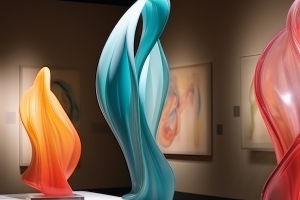What if art could breathe reality? Hyperrealism does just that by crafting stunningly lifelike pieces that compel viewers to question their perceptions.
This captivating genre transcends traditional realism by imbuing ordinary moments with extraordinary precision, inviting audiences into a world where art and reality intertwine seamlessly.
This astonishing art form doesn't just imitate life—it challenges our very perception of reality, blurring lines until we question what our eyes reveal. Prepare to be captivated by creations more vivid than life itself. Friends can join the journey into hyperrealism and discover why it has become a significant force in the contemporary art landscape.
Realism's Raw Roots
Before hyperrealism's dazzle came Realism's revolution. In the mid-19th century, artists like Gustave Courbet rejected idealized fantasies. They turned to miners, farmers, and gritty streets, finding profound beauty in the unvarnished truth. Courbet’s "The Stone Breakers" honored laborers' toil, proving everyday reality held its own powerful drama, setting the stage for ever-more precise observation.
Photorealism's Precision
The late 1960s birthed Photorealism, a direct offspring of photography. Pioneers like Chuck Close and Richard Estes used projectors and grids to replicate photos with fanatical accuracy. Estes painted gleaming cityscapes reflecting in chrome, while Close rendered colossal portraits pixel-by-pixel. Yet, this was replication—capturing the *camera's* eye, not necessarily the soul beneath.
Hyperrealism Emerges
Hyperrealism pushed further, emerging in the 1970s. It absorbed Photorealism’s technique but injected intense emotional resonance and heightened detail. Artists aimed not just to copy a photo, but to create a new, intensified reality—often sharper, clearer, and more tactile than the source material. It became commentary, not just copywork.
Digital Revolution
Modern Hyperrealism embraces digital tools. Artists like Bert Monroy craft entire worlds in software, achieving details impossible with traditional brushes. Digital layering allows microscopic precision—every strand of hair, every pore, every refraction in a water droplet. This tech fusion expands possibilities, creating illusions so convincing they defy belief.
Tactile Textures
Unlike smoother Photorealism, Hyperrealism revels in texture. Artists amplify the tangible: the roughness of peeling paint, the sticky gloss of melted ice cream, the downy softness of a peach. This focus on the tactile invites touch, creating a multisensory illusion that flat images cannot achieve. You *feel* the surface before you.
Emotional Depth
Beyond technical skill lies emotional storytelling. Duane Hanson's life-sized sculptures of tourists or cleaners aren’t mannequins; their slumped postures and weary expressions whisper narratives of modern existence. Hyperrealism imbues the mundane with psychological weight, making us confront the humanity in frozen moments.
Monumental Scale
Scale is deployed for impact. Ron Mueck crafts newborns or elderly figures at colossal sizes or miniature scales. His giant crouching boy forces viewers into a close encounter with vulnerability. This distortion heightens the visceral reaction, making the familiar profoundly alien and unforgettable.
Originality Question
Critics sometimes challenge its originality: "Is it just skilled copying?" Yet, the artist’s choices—subject, cropping, lighting, the *intent* behind amplifying specific details—transform the work. A hyperrealist painting of a rusted truck isn’t just a truck; it’s a meditation on decay, nostalgia, or industrial power.
Modern Themes
Contemporary hyperrealists tackle urgent themes. Audrey Flack's vanitas still lifes (cosmetics, jewelry, fading flowers) critique consumerism. Others depict urban isolation or environmental fragility. This elevates technique into social dialogue, proving meticulous realism can carry powerful conceptual weight.
Future Frontiers
The future blurs boundaries further. Artists combine traditional painting with 3D printing, augmented reality overlays, or AI-assisted rendering. The core mission remains: to explore perception and reality with ever-more sophisticated tools, ensuring Hyperrealism continues to astonish and provoke.
Conclusion
Hyperrealism is more than technical mastery; it’s a philosophical inquiry into seeing and believing. Next time you encounter a hyperrealist work, Lykkers, lean close. Study the impossible detail. Feel the texture with your eyes. Ask what emotion it evokes beyond the "wow" factor.
This art doesn't just mimic reality—it holds a magnifying glass to the overlooked beauty and complexity humming within our ordinary world. Visit a gallery, stand before these marvels, and let your senses be deliciously deceived. Reality, it seems, is just the starting point.


